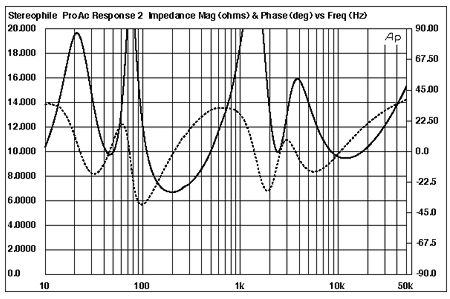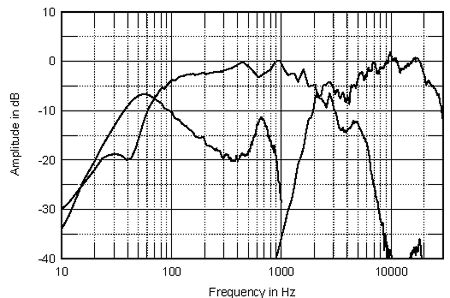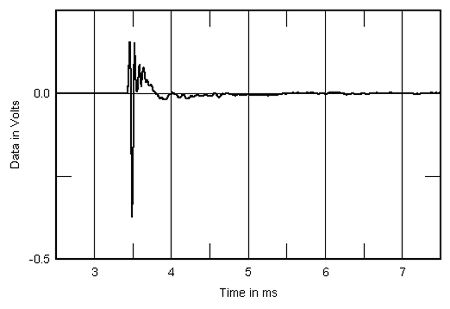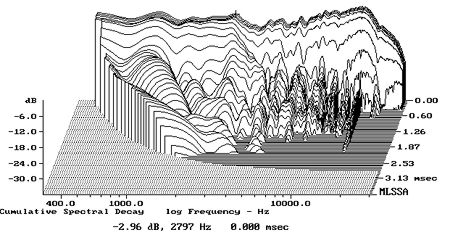| Columns Retired Columns & Blogs |
ProAc Response Two loudspeaker Measurements
Sidebar 3: Measurements
The Response Two is one easy speaker for an amplifier to drive, as can be seen from its plot of impedance magnitude and phase (fig.1), which only drops below 8 ohms in the lower midrange. The double hump in the bass is typical of a reflex design, the saddle between the two peaks indicating the port tuning of 47Hz. That the lower peak has a smaller magnitude than the upper one ties in with the rather overdamped alignment. This is due in part to the array of drinking straws in the port, something that has been a feature of Tyler-designed loudspeakers for well over a decade.

Fig.1 ProAc Response Two, electrical impedance (solid) and phase (dashed). (2 ohms/vertical div.)
The individual responses of the ProAc's drive-units can be seen in fig.2. The tweeter rolls in above 2.2kHz, though the woofer is rather uneven both at the top of its passband and in the manner in which it rolls out. Overall, however, the Response's response trend is fairly flat, as can be seen from the righthand plot in fig.3, which shows the speaker measured on the tweeter axis at 45" with DRA Labs' MLSSA system and averaged across a 30° horizontal window. A slight energy excess can be seen at 10kHz, which might add a degree of sibilance emphasis but is otherwise harmless. The low treble seems a little uneven, with a slight suckout centered on 600Hz. Because this measurement does not have a great deal of frequency resolution below 1kHz, I am loath to make further mention of this suckout except that it neatly coincides with a peak in the port's nearfield output, which can also be seen in fig.2.

Fig.2 ProAc Response Two, acoustic crossover on tweeter axis at 45", corrected for microphone response, with nearfield responses of woofer and port, plotted below 300Hz and 1kHz, respectively.

Fig.3 ProAc Response Two, anechoic response on tweeter axis at 45", averaged across 30° horizontal window and corrected for microphone response, with the complex sum of the nearfield woofer and port responses, taking into account acoustic phase and distance from the nominal farfield point, plotted below 300Hz.
Apart from that aberration, the port's output appears to be centered on 55Hz, a little higher than that implied by the impedance plot (fig.1). I have noticed this apparent misalignment before with over-damped reflex speakers. Despite the ProAc's small size, fig.3 implies that it has reasonable bass extension; near to the bottom notes of the double-bass, for example.
Fig.4 shows how the sound of the speaker changes as the listener moves to the side of the tweeter axis, with the the changes from 0° to 90° on the woofer side of the asymmetrical baffle shown to the rear and the changes on the tweeter side shown to the front. (As only the changes are shown, the reference on-axis response in these graphs appears to be a straight line.) While the typical off-axis gulley at the top of the woofer's passband is evident on both sides, that on the tweeter side is much deeper, which is presumably why ProAc recommends placing the tweeters on the inside edges of the speakers. In this way, the reflections of the speakers' sounds from the sidewalls will be more evenly balanced and therefore less disruptive to the Response Two's perceived balance.

Fig.4 ProAc Response Two, lateral response family at 45", normalized to response on tweeter axis, from back to front: differences in response 90–5° off-axis on tweeter side, reference response, differences in response 5–90° off-axis on other side.
These curves also show that if you find the speakers to be a little forward in the lower treble, this can be ameliorated by firing them straight ahead rather than toeing them in to the listening position. The third trace from the top in fig.4 implies that this will pull down the energy in the low treble, though this will be at the expense of some early top-octave rolloff.
Similarly, fig.5, which shows the changes to be experienced when the listener moves up and down in front of the speaker, implies that the Response Two will probably sound best when auditioned on or below the tweeter axis, mandating the use of high stands. Sit or use stands so that your ears are above the tweeter and the balance will sound a little sucked-out.

Fig.5 ProAc Response Two, vertical response family at 45", normalized to response on tweeter axis, from back to front: differences in response 45–5° above axis, reference response, differences in response 5–45° below axis.
There are no surprises in the impulse response (fig.6) or the step response (fig.7), apart from what might be a couple of reflections from either the baffle edges or the raised lip below the port within the first 1ms or so. Using the MLSSA system's post-processing power to calculate how the response changes as the impulse in fig.6 dies away gives the cumulative spectral-decay or "waterfall" plot shown in fig.8. Though the initial decay is quite clean, this is overall rather less tidy in the treble than I've come to expect. Note, however, that the post-impulse hash is evenly spread, which is perhaps why CG didn't comment on any particular graininess to the sound. The cursor is positioned at the frequency of what is probably a woofer-cone problem, 2840Hz. Though this is not extreme in nature, it might add a slight nasality to the Response Two's sonic signature.

Fig.6 ProAc Response Two, impulse response on tweeter axis at 45" (5ms time window, 30kHz bandwidth).

Fig.7 ProAc Response Two, step response on tweeter axis at 45" (5ms time window, 30kHz bandwidth).

Fig.8 ProAc Response Two, cumulative spectral-decay plot at 45" (0.15ms risetime).
Finally, I examined the behavior of the cabinet walls with a simple accelerometer, as explained in June (pp.205–207). As CG noted, this ProAc is surprisingly massively built, which some might think will result in a non-resonant structure. Adding mass alone, however, though it will change the frequencies of resonances, will not eliminate them. The same is true for making a cabinet more stiff. What is necessary to reduce the level of resonances is to add some kind of compliance: damping. (Although there is some evidence that a little damping can be worse than none, as it will make resonances more audible, not less, due to the reduction in their "Q.")
Fig.9 shows the output of the accelerometer attached midway up the ProAc's side wall, converted to a "waterfall" plot. Despite the Response Two's superb construction, there is still a significant resonant mode apparent at 300Hz, as well as some minor modes higher in frequency. This 300Hz mode was also observed on the top and rear panels, though at a lower level. However, this resonance is actually quite low in level, around 16dB lower for the same electrical drive than the resonances noted in the inexpensive PSB Alpha (also reviewed this month). Also, being so narrowly defined in frequency, its effect on music will probably be subtle, though it probably ties in with the slight "woodiness" I noted on the sound of bass guitar (see my "Follow-Up" review of the Acoustic Energy AE1 elsewhere in this issue). Its effect will also be dependent on the specific stand used, which is presumably why RoomTunes' SpeakerClamp effects a noticeable improvement on the sound of the Response Two.—John Atkinson

Fig.9 ProAc Response Two, cumulative spectral-decay plot calculated from the output of an accelerometer fastened to the center of the cabinet's side panel (MLS driving voltage to speaker, 7.55V; measurement bandwidth, 2kHz).
- Log in or register to post comments




































